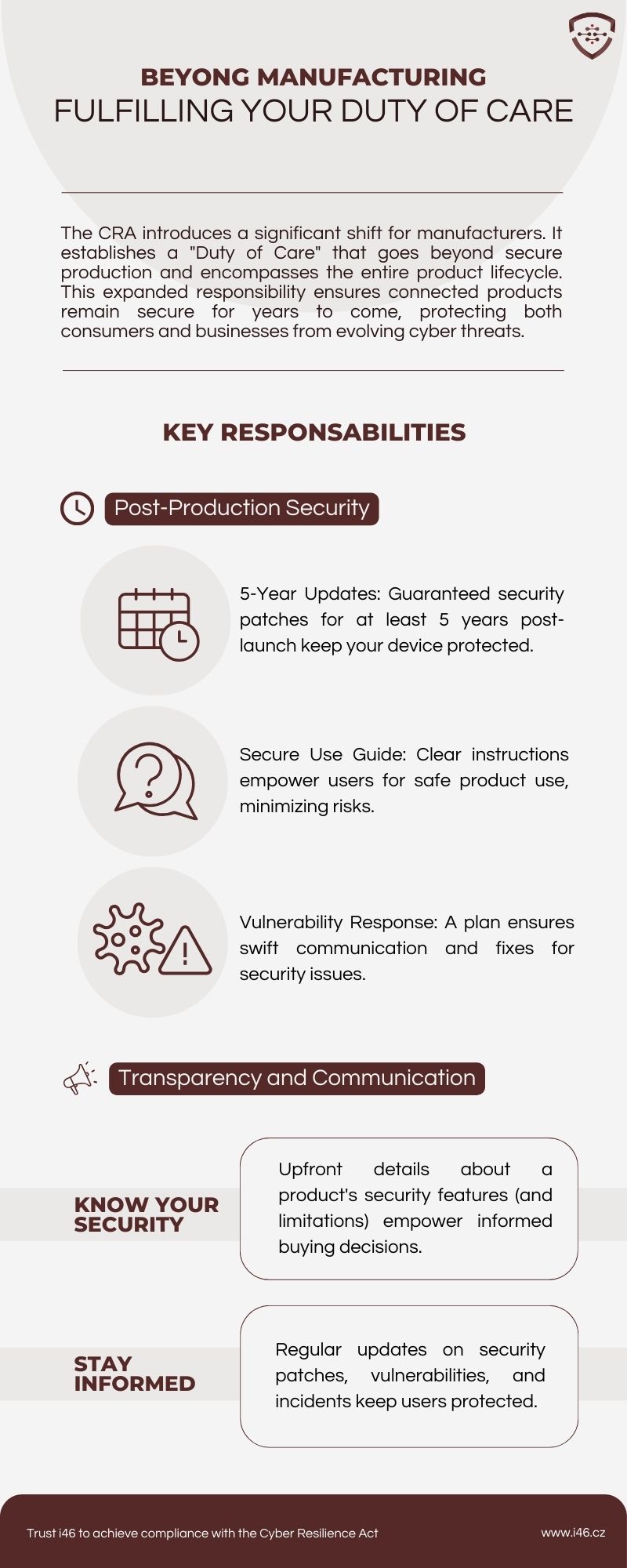The Cyber Resilience Act: A Duty of Care for a Securely Connected Future
The digital landscape continues to expand, weaving its tendrils into nearly every facet of our lives. From smartphones to smartwatches, thermostats to toys, an increasing number of products boast a “connected” status. This connectivity, while offering undeniable convenience, also introduces a vulnerability – the potential for cyberattacks. To address this growing concern, the European Union (EU) has introduced the Cyber Resilience Act (CRA), a regulation that marks a significant shift for manufacturers.
Beyond Production: The Duty of Care
Traditionally, cybersecurity efforts have focused on secure production practices. Manufacturers implemented measures to ensure products were free of vulnerabilities at the time of creation. However, the CRA introduces the concept of a “Duty of Care.” This expanded responsibility extends far beyond secure production, encompassing the entire product lifecycle.
The Duty of Care compels manufacturers to prioritize cybersecurity throughout a product’s journey, from design and development to post-sale maintenance and eventual end-of-life. This holistic approach ensures connected products remain secure for years to come, mitigating the risk of vulnerabilities emerging and being exploited by malicious actors.
Benefits for Consumers and Businesses
The ramifications of the Duty of Care are far-reaching, benefiting both consumers and businesses.
- Enhanced Consumer Protection: Consumers can be confident that the connected products they purchase are built with security in mind. The CRA mandates manufacturers to provide clear information about a product’s security features, empowering consumers to make informed choices. Additionally, the Act establishes processes for reporting vulnerabilities and ensures timely security updates, minimizing the window of opportunity for cyberattacks.
- Reduced Risk for Businesses: Businesses that rely on connected devices within their operations can benefit from the improved security posture mandated by the CRA. This translates to less disruption from cyberattacks, safeguarding critical data and business continuity. Additionally, the Act fosters a level playing field by ensuring consistent security standards across connected products, streamlining compliance efforts for businesses.
Addressing Evolving Threats
The digital threat landscape is constantly evolving. Cybercriminals develop increasingly sophisticated methods to exploit vulnerabilities, making a one-time security check at production insufficient. The Duty of Care, by mandating ongoing maintenance and security updates, ensures products remain resilient against these evolving threats.
Manufacturers will be required to actively monitor for vulnerabilities and patch them promptly. This proactive approach is crucial in the fight against cybercrime, as it minimizes the time attackers have to exploit a security flaw.
A Framework for Secure Innovation
The CRA does not stifle innovation. In fact, it establishes a framework within which manufacturers can create secure products with confidence. By outlining clear cybersecurity requirements, the Act provides a roadmap for secure development practices. This predictability allows manufacturers to focus on innovation, knowing that their products will meet the necessary security standards.
Implementation and Impact
The CRA is expected to come into effect in early 2024. Its implementation will require collaboration between manufacturers, regulators, and cybersecurity experts. Manufacturers will need to adapt their production processes and invest in tools and expertise to ensure compliance with the Duty of Care.
The long-term impact of the CRA will likely be significant. By fostering a culture of cybersecurity throughout the product lifecycle, the Act has the potential to create a more secure digital ecosystem for both consumers and businesses in the EU. This, in turn, can serve as a model for other regions seeking to strengthen cybersecurity in a world increasingly reliant on connected devices.
Challenges and the Road Ahead
While the CRA represents a positive step forward, challenges remain.
- Complexity of Supply Chains: Modern products often involve complex supply chains with components from multiple manufacturers. Ensuring all actors within the chain comply with the Duty of Care will require effective communication and collaboration.
- Resource Constraints: Small and medium-sized enterprises (SMEs) may face resource constraints in implementing the necessary security measures. The EU has acknowledged this challenge and has indicated a willingness to provide support and resources to help SMEs comply with the CRA.
- Global Harmonization: The CRA is a regional initiative. Ideally, similar regulations would be adopted globally to ensure a truly secure and trustworthy digital environment.
The Cyber Resilience Act represents a significant step forward in securing our connected future. By establishing a Duty of Care, the EU is setting a high bar for manufacturers, prompting a paradigm shift towards a more holistic approach to cybersecurity. While challenges remain, the potential benefits of the CRA are undeniable, paving the way for a more secure and resilient digital landscape for all.




